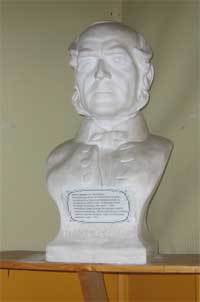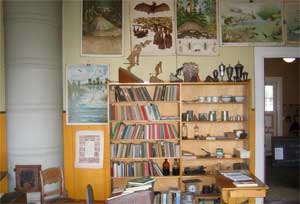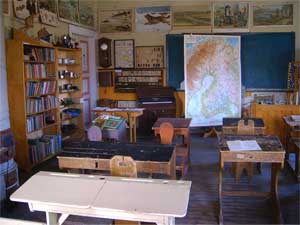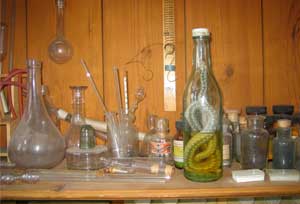
|
Keihäslahti Old School - Photos © Anita Leppälahti 2008, design, research, text, editing, image editing, translation © UJ 2004 - 31.8.2011, 26.3.2012 -  Keihäslahti old school had originally two separate schools for boys and girls. They both had classrooms and entrances of their own.
The school building of the Keihäslahti old school is located next to the present Keihäslahti Comprehensive School and the Gym Hall about Stages of Schooling In the beginning the ability to read was acquired in the Sunday schools of the parishes, the church catethetical meetings or by private teaching masters, but in the end the parents themselves were obliged to do the teaching. Schooling on the whole Kuru area began in a fixed space after the Keihäslahti old schoolhouse was completed, where the first elementary school of Kuru started on 1.9.1881. Here entered also the children of Parkkuu their road of learning, till the first village school of Parkkuu got started in the year 1904. The idea of founding a school had risen already among the municipal council in 1867 when the municipal autonomy had started, but considering the affair, gathering the funds and building materials and finding a suitable building site for it took so much time that the construction work could start not until in the year 1877.  Skillful carpentry of old times surrounding the doors.
 The statue of Uno Cygnaeus (en), the father of the Finnish elementary school system, held the place of honour in every school.
The funds for the building project were gathered by collections, dances and other sorts of communal cooperation. Also the money from distilling spirits and the income of the hay which had grown on the building site and sold in auctions were transferred to the building fund. The building site on Suova hill, part of the lands of the official residence of Kuru Lieutenant, was donated by the state, farmers from Kuru brought the building logs, shingles and other building materials were bought. Based on the proposition of the governing board the municipal council decided that the bulding should be 16 fm. long, 6 fm. and 1 ell broad and that it should have 9 rooms. A fathom or fm. as a unit of measure is 3 ells and 1 ell 24 inches or 0,594 metres. The school building was finally completed in the year 1881 after the drawings by carpenter Sandström. The School Building Completed Into the actual schoolhouse were built two classrooms, two teachers' apartments and two handwork classrooms into the attic. Opposite to the school building rose another building with a hall used as communal house and gym hall, a bakery and three dormitory chambers for pupils from further away. After the senate had granted 600 marks government subsidy for hiring a teacher, and the first one in the boys' school became Juho Tyyskä (1881-1884) and the manageress of the dormitory madame Eeva Konttinen, the school could start its functioning in autumn 1881. The girls' school started not until 1888, when the school got its first female teacher, Anna Auer (1888-1895). Information
Etuovilla ry Sources in Finnish
Erkki Laitinen, Kurun historia 1867-1918, Kurun kunta, 1988 Old Educational Pictures
Koulutauluja, Pihlajavesi, Keuruu (fi) Keihäslahti or Suova school was planned to be the school for the whole Kuru, but most of the pupils came from the parish village and the closest other villages, Karjula, Niemikylä and Parkkuu. In the first year 24 pupils registered to the school lasting for 4 years, three of the starting pupils were girls. After new registrations and resignations the final number of pupils was 27. The subjects of instruction in the first elementary schools in general were down-to-earth reading, writing, arithmetics, Bible studies, housekeeping, agricultural work, handwork and gymnastics. When the school had its 50th birthday in the year 1931, there were present at the celebration some of its first pupils: Aku Pohja, Kalle Kapee, wife of Ylä-Korpula, V. Salminen, Mrs Rinne, vicar Emanuel Kolkki, Juho Tienari, Otto Toijala and Kalle A. Ylä-Poikelus. The maximum amount of schools in Kuru has been 16 schools in the beginning of autumn 1940. Since autumn 2010 there has been left no more but Keihäslahti school. In the year 1964 the school changed its name into the Elementary School of the Parish Village, and in the year 1968 was inaugurated the new school building planned by architect Reino Ilveskoski, where also the old school was moved. Now the official name of the school is Keihäslahti Comprehensive School.  Sheet metal stove and educational pictures. Those were the days!
Until quite recently the old school of Keihäslahti had been used as the scene of various happenings and in summertime exhibitions and concerts have taken place there. The school served well as a place for private or public occasions of about 100 persons. The School Museum In summertime the building serves also as a school museum with collected material from the 1950's to the 1960's. There are among all abacuses, old books and teaching material used in all the old schools of Kuru. The oldest item is the Bible donated to the school already in the year 1880, but some of the items has been used in education still in the 1970's. An oil painting by Heikki Asunta representing the old school, the record player and tape recorder from the 1950's are also donations for using them as educational equipment. Also the articles from the beginning of the 1900's donated by the heirs of author Tauno Peltomäki are on display in the school museum.  The school museum has still during Kuru municipality been open for public only in every July during the annual Kuru Festival Week, but has now after the municipality merger been closed. Educational Supplies in Elementary Schools in the 1930's Kansakouluasiain käsikirja, Jaakko Laurila, Otava, 1932, the 3rd edition, the 2nd edition was published in 1926. On the title page of this Handbook on Elementary School Affairs the handwritten text "Tapiolan Kansakoulun Op. Käsikirjasto 1936" tells that it had belonged to the reference library of the teachers of Tapiola elementary school in 1936. This paperbound edition has 488 pages and it was found at a flea market in Kuru on 9.12.2008. In the handbook there are among all the complete law text of the first Law of Compulsory Education in Finland 15.4.1921 and other laws and statutes, e.g. the law of summer colonies and kindergartens, directions on selecting the building site of a schoolhouse and building and furnishing it. The book contains also instructions for starting a school library and organizing the pupils' health care, regulations for the functioning of the school boards, choosing teachers and determining their salaries both in money and in nature. That nature part meant for example the teacher's apartment, cultivated field for own use and pasture grounds enough for one cow. There are also lots of different forms and school certificate models, lists of books used in schools, elementary schools' district division and the drawings of the desks accepted by the National Board of Education in the year 1923. The following list of educational supplies is on the pages 251-252. 1 Suitable is e.g. so called reform board. Note from the writer of the book. "The List of the Educational Supplies Needed in the Lower Grades of the Elementary Schools.
 In the classroom of the school museum there are books, abacus, clock on the wall, harmonium, models for penmanship, desks, blackboard, the map of Finland ...
 ... and among the chemistry supplies even a real snake.
The list is not meant to be perfect in that sense that also other suitable supplies would not be allowed and supported; the equipment in the list can anyway be considered sufficient for the lower grades of the elementary schools. Because in the lower grades of the elementary schools objects must often be shown to the pupils on the teacher's desk, it should be strictly horizontal and large enough; with the extensions lifted at its both ends e.g. 150 x 75 cm. Of acquiring the educational supplies, considering the present economic situation, the National Board of Education says in its circular letter 20/4 1929 as follows:
This concerns as well upper as lower grades in the elementary schools, perhaps mainly the first ones."
|




